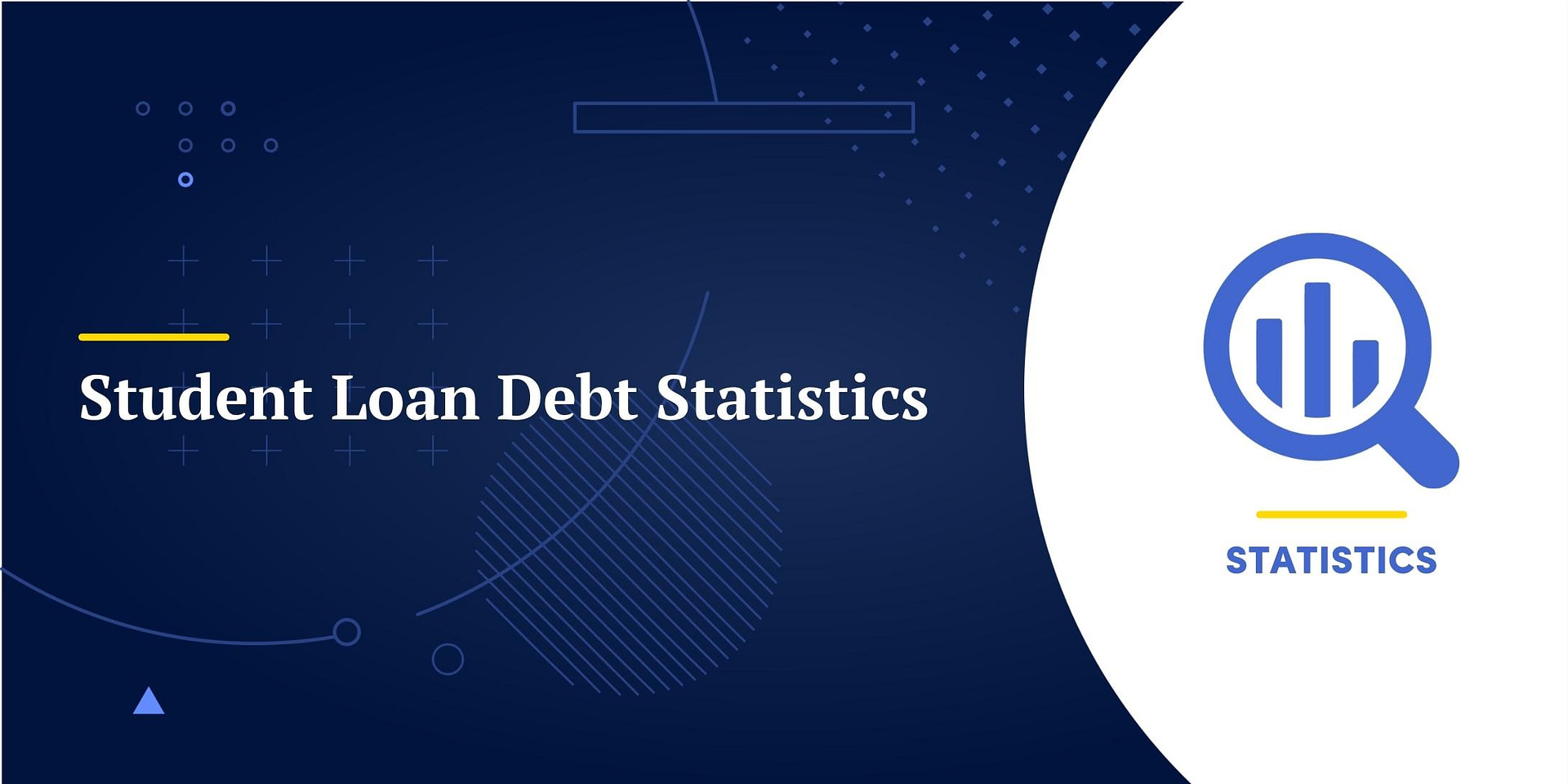Student loans can be a way to get the education you need to pursue your dream career, but paying them off can take a long time. Most borrowers will be paying them off for over ten years and they can be extremely stressful for fresh graduates looking for their first jobs.
How bad is the student loan debt crisis? These student loan debt statistics shed some light on the problem and put it in perspective. We data that will show how much borrowers owe, the types of loans and schools that run up the highest debt balances.
Key Findings
- Approximately 1 in 7 Americans (13.5%) has student loans.
- The average federal student loan debt per borrower in 2022 is $37,667.
- The highest number of borrowers are aged 25-34.
- 2.5 million Americans in their 60s and older are still paying off student loans.
- The District of Columbia has the highest average student loan debt at $54,945.
- 7.8% of all student loan debt is in default, and one in ten Americans have defaulted on a student loan.
- Most borrowers need up to 20 years to pay off their student loans.
- Less than 30% of applications for student loan forgivenss get approved.
- Northwestern University has the most student debt.
Total Student Loan Debt in the U.S.
The total student loan debt in the United States in 2022 is $1.74 trillion dollars. That’s higher than the total GDP of Canada ($1.65 trillion), Russia ($1.578 trillion), or Australia ($1.323 trillion).
Total student loan debt has been on a fast rise ever since 2006 when The Fed started tracking the data, rising on average by 1.15% per year. The good news is that the growth has been slowing down in the past couple of years, with an overage year-over-year increase in the last five years being 0.66%.[1]✓
✓ Trusted source
The Fed
The United States of America’s central banking system is called the Federal Reserve System. The Federal Reserve Act specifies three primary goals for monetary policy for the central banking system: increasing employment, preserving price stability, and lowering long-term interest rates.
Total Federal Student Loan Debt
Federal student loans account for $1.62 trillion dollars of the total student loan debt[1]. This includes both outstanding principal and interest balances. These loans are held by 43 million borrowers.
Total Private Student Loan Debt
The remaining 34 billion dollars are held by private lenders. This means that only 2.10% of the total student loan debt is held by private lenders.[1]
Student Loan Debt by Type of Loan
The Stafford Unsubsidized Loans have the highest balance of debt among all federal loans, $571.9 billion. The second highest balance, $549 billion, is held in consolidation loans, followed by $293 billion in Stafford Subsidized loans.[2]
Total Student Loan Debt By Type Of School
Public schools account for the largest share of student loan debt, with a total of $714.6 billion owed. Foreign schools registered the lowest amount of student loan debt with $20.6 billion.[2]
Average Student Loan Balances
The average federal student loan debt per borrower in 2022 is $37,667.[1]
Most student debt is held in large loans, but most borrowers have small loans. The chart illustrates that discrepancy by showing the percentage of the total student loan debt by loan amount and the percentage of borrowers by loan amount. This indicates that a relatively small number of borrowers accounts for a large percentage of the total student debt.
Average Student Loan Debt by Type of Loan
Average Debt By Type Of School
While the average student debt for a person attending a public school is $28,257, the loan amount that a person attending a foreign school has to pay off totals an astonishing $103,000. Even if you decide to pay it off over the next 20 years, your payments would be around $430/month. The amounts may be so high because people that leave to study in another country usually do that for their Master’s Degree or PhD.[2]
Who Has Student Loan Debt?
Approximately 1 in 7 Americans (13.5%) have student loan debt.
Average Student Loan Debt By State
The District of Columbia has the highest average student loan debt at $54,945. Data shows that 17.3% of the DC residents have student loan debt, some of them owing more than $200,000.[1]
Average Student Debt By Age
Data shows that the 25-34 age group has the highest number of borrowers (15 million) among all five categories, closely followed by people in the 35-49 age group (14.5 million).
There are over 2.5 million Americans in their 60s, or even older, that are still paying off student loans.[2] In some cases, these may be students who went back to school later in life.
Average Student Debt By Gender
Statistics show that women owe on average $1654 more than men for their student loans.
If that doesn’t seem like a big difference, keep in mind that women graduating with a bachelor’s degree expect to earn an average of $35,338 as a starting wage. That’s 19% less than what men anticipate earning.[3]
Average Student Debt By Race
With an average student loan debt of $36,612, statistics show that members of the black community have the highest levels of debt. Asians appear to have the lowest amount of student debt, with an average loan balance of $25,380.[3]
Student Debt By Income
Studies show that people with an annual income of $80,000 to $89,999 have the highest loan balances with an average of $51,000.
Interestingly enough, those with an annual income of $90,000-$100,000 pay $10,000 less than people with an income of $80,000-$89,000.[1]
How Many People Default On Their Loans?
7.3% of student loan holders were in default in 2018. Student loan defaults were frozen as part of the COVID-19 student debt relief package, which has been extended multiple times.[1]
How Long Does It Take to Pay Off Student Loans?
Although the ideal timeline for a borrower to pay off the loan debt would be 10 years, most borrowers need up to 20 years to pay it off, while some take over 45 years to repay student loans. There are people that are 65+ still paying off student loans, though some went back to school later in life.[1]
Student Loan Debt Forgiveness
Out of a total of 495,407 received applications for forgiveness, 131,811 have been approved while 212,876 of them are still pending. A total of 137,438 applications have been denied, meaning denial is more common than debt forgiveness.[2]
Which University Has the Most Student Debt?
Northwestern University has the most student debt among the top 20 universities in the U.S. with an average of $35,129 per student.[4]
An Intractable Crisis
The student debt crisis has been growing for decades. It’s rooted in a simple historical fact: the cost of education has increased much faster than average earnings, especially for young people. While the workforce increasingly demands higher levels of education, the rewards tend to be delayed.
The soaring cost of education makes it essentially impossible for most American high school students to attend college without debt.
Georgetown University’s Center on Education and the Workforce notes in a recent report that “It takes longer today than in the past for young people to latch on to good jobs. That’s because young people need more education and training than they once did to get a job that pays middle-class wages.”
Despite this reality, federal student loans begin accruing interest immediately upon graduation. That means that by the time many young graduates achieve their earning potential, their loans have mushroomed to unmanageable proportions.
This situation is clearly unsustainable. With the workforce demanding ever-higher levels of training, pricing young people out of higher education is a one-way road to economic disaster.
Policy solutions are needed. The current proposals for debt relief are a start but do not address the fundamental imbalance between education costs and earnings in the first decade of work.
For individual students or recent graduates, of course, policy solutions are not likely to come in time. All we can do is arrange our affairs as well as we can and make the most of a bad situation. If you are starting college or have a child who is starting college, start with this guide to college without debt. If you’re struggling to pay student debt, try these 13 Tips for How to Pay Off Your Student Loan Debt.
Last Updated: August 31, 2022
The content on finmasters.com is for educational and informational purposes only and should not be construed as professional financial advice. Finmasters is not a financial institution and does not provide any financial products or services. We strive to provide up-to-date information but make no warranties regarding the accuracy of our information.





